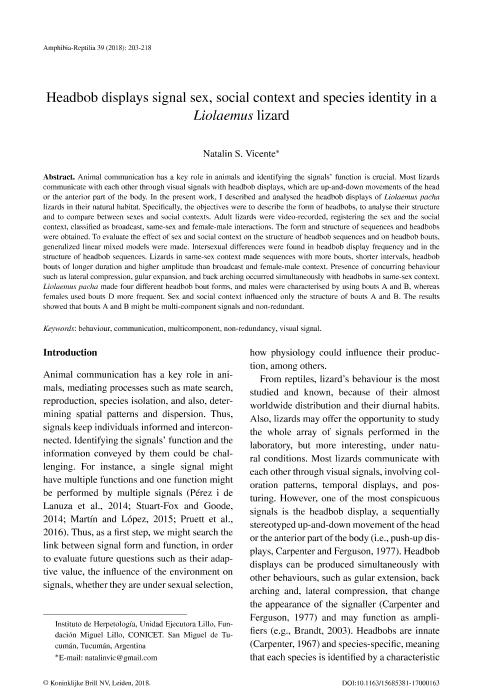Artículo
Headbobs displays signal sex, social context and species identity in a Liolaemus species
Fecha de publicación:
04/2018
Editorial:
Brill Academic Publishers
Revista:
Amphibia-Reptilia
ISSN:
0173-5373
Idioma:
Inglés
Tipo de recurso:
Artículo publicado
Clasificación temática:
Resumen
Animal communication has a key role in animals and identifying the signals’ function is crucial. Most lizards communicate with each other through visual signals with headbob displays, which are up-and-down movements of the head or the anterior part of the body. In the present work, I described and analysed the headbob displays of Liolaemus pacha lizards in their natural habitat. Specifically, the objectives were to describe the form of headbobs, to analyse their structure and to compare between sexes and social contexts. Adult lizards were video-recorded, registering the sex and the social context, classified as broadcast, same-sex and female-male interactions. The form and structure of sequences and headbobs were obtained. To evaluate the effect of sex and social context on the structure of headbob sequences and on headbob bouts, generalized linear mixed models were made. Intersexual differences were found in headbob display frequency and in the structure of headbob sequences. Lizards in same-sex context made sequences with more bouts, shorter intervals, headbob bouts of longer duration and higher amplitude than broadcast and female-male context. Presence of concurring behaviour such as lateral compression, gular expansion, and back arching occurred simultaneously with headbobs in same-sex context. Liolaemus pacha made four different headbob bout forms, and males were characterised by using bouts A and B, whereas females used bouts D more frequent. Sex and social context influenced only the structure of bouts A and B. The results showed that bouts A and B might be multi-component signals and non-redundant.
Palabras clave:
BEHAVIOUR
,
COMMUNICATION
,
MULTICOMPONENT
,
NON-REDUNDANCY
,
VISUAL SIGNAL
Archivos asociados
Licencia
Identificadores
Colecciones
Articulos(UEL)
Articulos de UNIDAD EJECUTORA LILLO
Articulos de UNIDAD EJECUTORA LILLO
Citación
Vicente, Natalin Soledad; Headbobs displays signal sex, social context and species identity in a Liolaemus species; Brill Academic Publishers; Amphibia-Reptilia; 39; 2; 4-2018; 203-218
Compartir
Altmétricas




